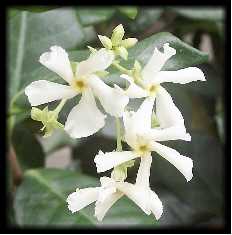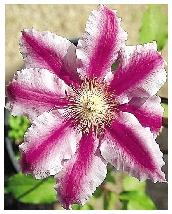Although often banished
to the southern suburban mailbox, vines
are wonderfully versatile plants. Needing
just a half-square foot of earth for their
roots, they can fit into spaces too small
to accommodate shrubs, yet they are also
capable of covering large areas.
Are you bothered by an unsightly view?
Vines can be used to cover up an unsightly
view or fixture such as an old barn or
a gutter downspout.
A vine may be just the leafy eradicator
you need. Does your deck or patio broil
in the noonday sun? A vine planted to
grow over an overhead structure can provide
welcome, cooling shade much quicker than
a tree can.
How 'bout an old and ugly chain link
fence - or any fence for that matter.
Turn it into a beautiful 'living fence'
with vines.
Landscape
Uses of Vines
Even in a relatively small home landscape,
a selection of climbers and ramblers can
provide the following:
Seasonal color
- There are vines
that bloom or offer some kind of interest
during almost every part of the year.
The onset of spring is marked by the
white, dogwood-shaped blossoms of Armandi
Clematis or the masses of bright yellow
trumpet flowers produced by Carolina Jasmine.
In mid to late spring, Wisteria takes
over. We like 'Amethyst Fall's', a native
variety of Wisteria, because it is les
invasive and blooms twice a year: April
and August.
Late spring brings on the masses of
wonderfully fragant whitem star-shaped
flowers of Confederate Jasmine, which
continue to mid-summer.
Summer brings a myriad of choices for
blooming vines, including hybrid clematis
and tropical selections such as Mandevilla
and Alamanda , which will often bloom
long into the fall before a killing frost
cuts them down.
One of our favorite flowering vines:
Madame Galen Trumpet Vine (Campsis radicans),
will produce clusters of its large salmon-red,
hummingbird magnet trumpet flowers from
July through September!
Another excellent selection for attracting
hummingbirds is the red Trumpet Honeysuckle
which will bloom off and on for up to
10 months of the year.
Signature vines of the fall include
Sweet Autumn Clematis (Clematis maximowicziana)
which produces an abundance of many small,
white sweetly fragrant flowers.
 |
Fragrance
- When planting any scented or fragrant
vine, be sure to place them where
their scent will be noticed. For example,
plant the evergreen Confederate Jasmine
vine (pictured to left) outside a
doorway that is used often, an open
window, or near a favorite sitting
area. |
Privacy
- A well placed vine
can provide the same amount of privacy
as a tall shrub, while taking up less
horizontal space. For this purpose, be
sure to choose evergreen vines, and train
them to cover a trellis thickly. Vines
can make a cheap-and-easy screen between
your house and the neighbor's by stretching
a width of chicken wire between two pressure-treated
posts and then weaving ivy through it.
As the ivy grows, the chicken wire quickly
disappears, leaving a green, live wall.
You can also extend the height of a typical
4-6' privacy fence by adding trellising
materials and an evergreen vine.
Shade
- Where summers are hot,
shade is a valuable commodity. Many types
of vines, including trumpet vine (Campsis
radicans) and Wisteria, grow with rampant
abandon and can cover a pergola or arbor
in a season or two, shading a patio or
walkway more quickly than a tree could.
Trumpet vine sports orange, red, or yellow,
trumpet-shaped flowers (depending on the
variety) that attract hummingbirds. Deciduous
vines can actually help to save energy.
Their shade blocks the hot sun, reducing
air conditioning costs all summer, while
in winter, bare stems let the sunlight
through, warming the house and lowering
heating bills.
Camouflage
- Vines give you the option of softening
hard elements in the home landscape. Let
the delicate foliage of Akebia hide a
chain link fence (it produces unusual
purple flowers in spring as a bonus).
Or, let a climbing hydrangea (Hydrangea
petiolaris) blur the rigid lines of a
stucco or brick wall. Homeowners with
a ramshackle shed or unsightly garage
could easily put this technique to work.
 |
One our our favorite
clinging vines is Creeping Fig. Creeping
Fig planted at the base of a stucco,
stone, or brick wall that is 8' in
height will cling and climb to the
top in one year! The effect is amazing.
Turn unsightly or just plain ugly
walls from a liability to an asset
using Creeping Fig or ivy. 'Wilson'
Ivy is our favorite selection for
this purpose because it will tolerate
sun or shade. |
 |
Clematis
- Widely grown for their colorful
flowers, clematis are among the most
popular of vines. Perhaps most familiar
are the modern hybrids with their
large, showy flowers and restrained
growth habit - many will only attain
heights of six to twelve feet, making
them ideal for growing over shrubs
and in other situations where a more
rampant grower would smother its neighbors.
Their blossoms encompass nearly the
entire color spectrum and blooming
times range from early spring to fall,
depending on the variety. At the nursery
we stock at least 25 varieties in
a single season. |
Growing
Vines
Most vines grow well in moist but well-drained
soil, but there are vines
for almost every soil and light condition.
Vines will need pruning to limit growth,
to thin the stems and branches and to
remove dead or damaged wood. Vines that
grow rapidly may need to be pruned at
frequent intervals.
Pruning
Clematis - Because there
are so many different types of clematis,
there is often confusion over when and
how to prune. For pruning purposes, clematis
fall into three main groups.
1. Group one blooms in the spring on
the previous year's growth. It does fine
without pruning, but when shaping is desired,
it should be cut back immediately after
it finishes blooming. 'Armandi' is the
only one in this category we sell at the
nursery and this is only when there hasn't
been a crop failure. Some years we have
it, some we don't.
2.Group two blooms in early summer, with
flowers forming on short stems that grow
from the previous season's leaf axil buds.
In early spring it should be cut back
to a pair of strong buds on all stems.
These account for maost of the clematis
we sell at the nursery.
3.Group three includes one's such as
Swet Autumn clematis which blooms in the
late summer or fall on the current season's
growth. Because it produces flowers on
new wood, it will bloom most profusely
if cut back each year in early spring
to between 12 and 18 inches from the ground.
Supporting
Vines
Before deciding on a support for a particular
vine, you must understand how the vine
climbs. Clinging vines which include climbing
Hydrangea, English ivy, and Creeping fig
adhere to a surface with tiny aerial rootlets
that grow from the stems and thus don't
need support.
Grasping vines, like grapes, climb by
grasping their support with tendrils.
Clematis are also considered a grasping
vine, as they use their petioles, or leaf
stems, to grab onto their support. These
types of vines can most easily grasp onto
wires or thin lattice pieces that are
spaced closely together. An ornamental
trellis with wide open spaces should be
backed with chicken wire or some similar
material to help grasping vines get a
toehold.
Twining vines climb by coiling themselves
around their support and do well on chunkier
supports such as lamp posts and porch
pillars. They will also weave themselves
in and out of open latticework as they
head in an upward direction.
Use the following technique to transform
a lamp post into a lush pyramid of flowering
vines: Drive several stakes into the ground,
forming a circle around the base of the
post. String twine from the stake to the
top of the post. Plant a vine next to
each stake, and as the vines grows, coax
them up the twine. You'll get a much fuller
look this way than if you were growing
them directly on the post. The same technique
can be used for growing a vine up an unsightly
gutter downspout.
In
Summary
Vines
are a wonderful vertical addition to any
landscape. Their uses are many and most
require verty little if any maintenance
once established. They only take up a
square foot of ground space in the landscape.
Simple pruning and training is all that
is usually necessary. Vines can be used
for the following purposes:
To grow
on:
- Mailboxes
- Fences
- Arbors
and other overhead structures
- Trellises
- Walls
- Gutter
Spouts
- Embankments
as erosion controllers
Vine
Listing |